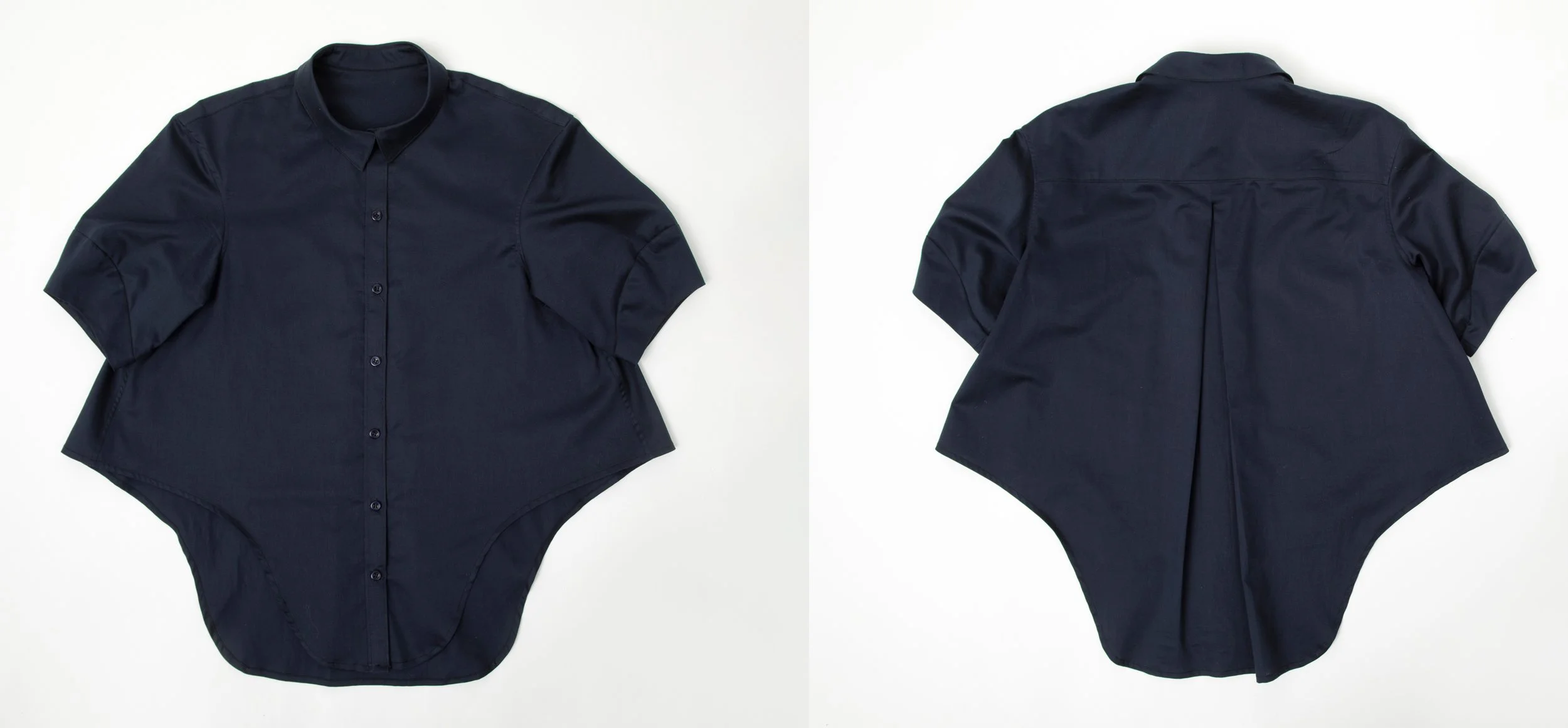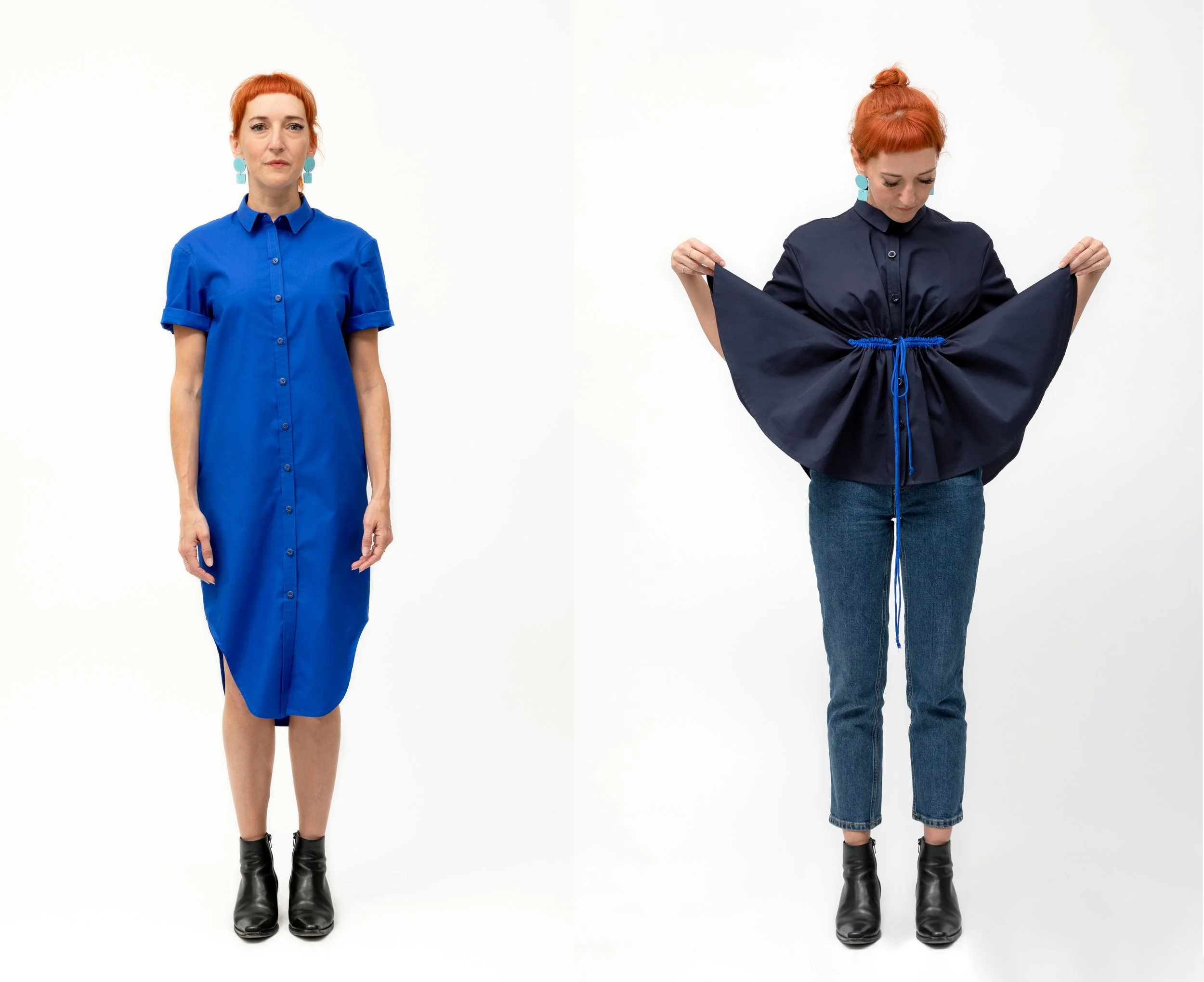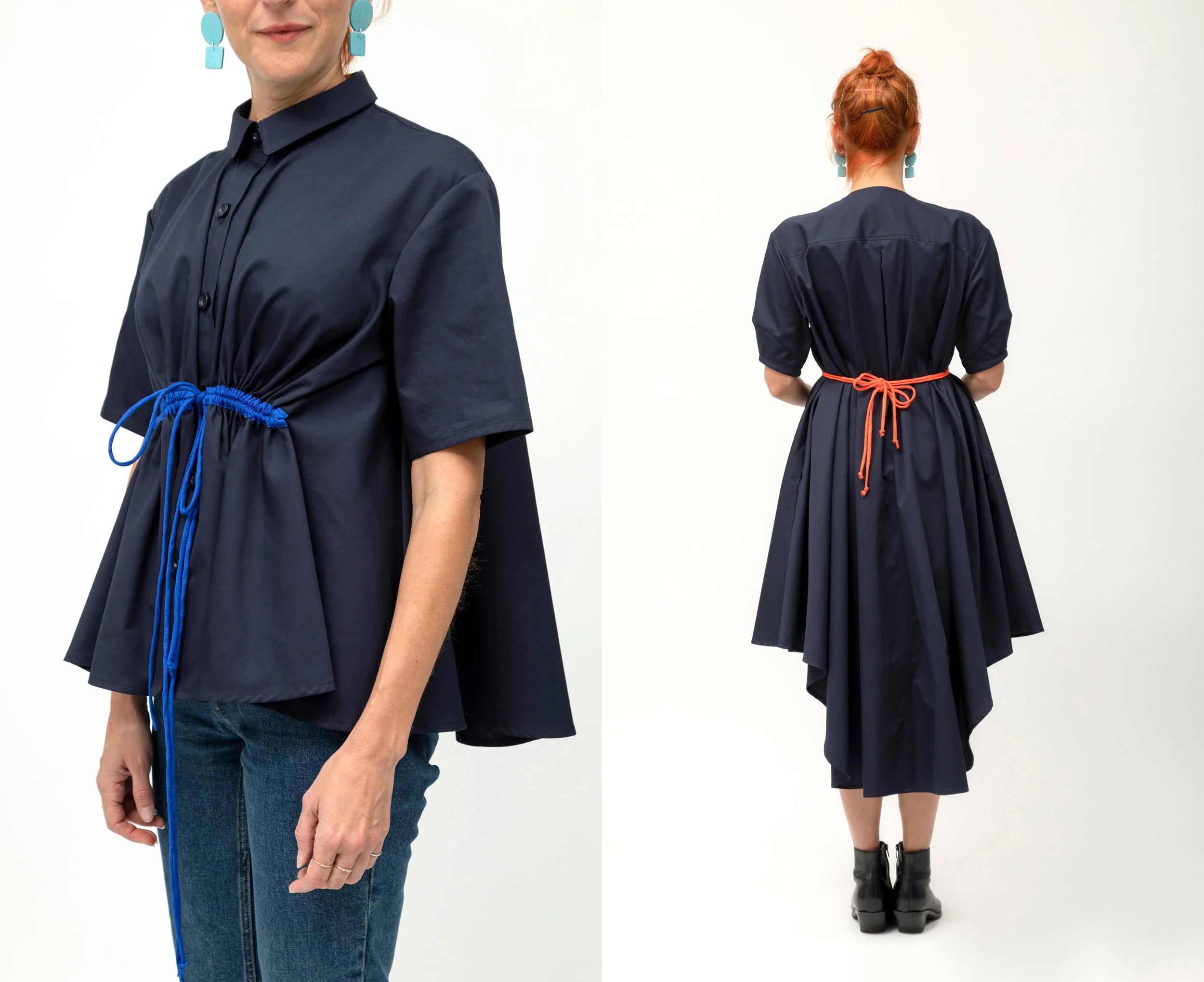One Pattern. Endless Variations.
As sewists refine their skills, they often feel inspired to experiment with pattern hacking and add personal touches to patterns they’ve used in the past. This is a natural progression for anyone feeling empowered by their ability to build a wardrobe that is truly unique to themselves. When our friend and fellow designer Abigail Glaum-Lathbury proposed a collaboration centered on the advanced home sewist, we knew it was the perfect moment to create a pattern that invites customization while introducing essential pattern-making techniques.
Our Guest Designer
Early in her career, Abigail Glaum-Lathbury launched her own womenswear line, featuring architecturally inspired garments that beautifully complemented the female form and were celebrated for their meticulous construction. Now a tenured professor and head of the Fashion Department at the School of the Art Institute of Chicago, she has shared her expertise in patternmaking, sustainable practices, and design theory with a new generation of designers. Abigail’s teaching encourages students to think critically about the intersections of fashion, culture, and ethics. Her art projects delve into the societal impacts of the fashion industry, addressing themes of consumerism, identity, and labor.
This marks the first collaboration between Open Studio Patterns and Abigail Glaum-Lathbury, though not the first for OSP co-founder, Jonnie. In 2012, Jonnie and Abigail joined forces to create Spectator, a mini collection that blended Jonnie’s menswear line with Abigail’s womenswear, resulting in a limited edition, all gender collection. This shared passion for collaborative design and empowering home sewists is what brought the Choice Pattern to life.
Introducing: The Choice Pattern
The Choice Pattern comes as a versatile base design that can be modified into several variations using pattern-making techniques demonstrated in our instructions and videos. The original pattern is a collared button-up shirt with dramatic tails and two sleeve options: short sleeve and lantern sleeve. We’ll guide you through essential techniques, such as adding or reducing fullness in the bodice and sleeves, extending it into a dress, drafting long sleeves, altering hem designs, and even creating a facing for a collarless neckline
While classified as “advanced” due to its customization options, the base design is accessible to intermediate sewists. Starting with the base pattern will help you get comfortable with its construction, providing a solid foundation as you progress into more advanced patternmaking techniques. It’s a great way to steadily build and expand your skill set.
The Variations
Of course, we encourage making the Choice base pattern in its original state because it’s already a super cool design that comes with more than one sleeve option. But we know you’ll be ready to flex your designer muscle at some point and try one (or more) of our alternative design elements at some point. Keep scrolling to get a better idea of what you might be able to achieve with this sewing pattern.
Collared or Collarless
The original Choice Pattern comes with all the pieces to make this dainty collared look. Abigail shares her recommendations for assembling the collar and collar stand in our video tutorials. Even a seasoned sewist may learn a new trick or two.
The collarless look can be achieved by creating a front facing that later gets assembled seamlessly with the back yoke and front plackets. We do include a collar facing in the pattern package, but also instruct sewists how to make one in case the shape of the neckline has been altered during one of the other pattern design adjustments.
Fullness
The most technical part of our video tutorial covers how to add or reduce fullness in the pattern pieces using some fundamental patternmaking techniques. The original Choice Pattern already has some fullness incorporated into the design. Sewists can use the method taught by Abigail to adjust the bodice to have even more fullness or transform the pattern to have more straight bodice lines.
Front Ties
Another unique detail designed by Abigail is the front ties, which are fed through channels topstitched onto the front bodice. Our tutorial demonstrates how to attach the channels to the front bodice pieces and how to create the cords using a loop turner—a useful skill for making spaghetti straps. The ties can be used to cinch only the front, leaving the back bodice full, or tied around the entire waist to create a shapely silhouette. Fullness was added to the bodices of both looks in the photo above.
Hemlines
Keep the dramatic tails or alter the hemlines to better suit your style. In our patternmaking tutorial, Abigail guides sewists on seamlessly adjusting hemlines. The options for hem shapes are endless, making this a perfect opportunity to get creative and try something new. The video tutorial demonstrates how to work with the pattern pieces and keep them aligned throughout the process
Lengths
This original Choice Pattern was designed to be easily modified into any length you desire. There won’t be much to get in your way of increasing or decreasing the length of the bodice which gives sewists more chances to use the Choice Pattern for additional makes. Make it a dress, a long vest or even cropped.
Sleeves
This base pattern comes with two sleeve options ready for you: a short sleeve and a lantern sleeve. But that’s just the beginning of your sleeve options. The armhole shape on the bodice is already designed to work well as a sleeveless option without any pattern adjustments; it’s simply finished with bias tape on the garment’s inside. Lengthening the short sleeve pattern to create a long sleeve is straightforward, as it follows the same steps used to lengthen the bodice.
Pockets
For those who won’t wear a garment without pockets, we’ve got you covered. The pattern file includes a patch pocket for the front bodice and a pocket bag for inseam pockets. We also provide instructions on how to add extensions to the side seams, which serve as an inside facing for the side seam pockets. If you prefer a sleeker look, feel free to skip the pockets altogether for a clean, streamlined finish.
Fabric Suggestions
The Choice Pattern was designed to be used as a button up shirt, a shirt dress, a long vest and even a long overshirt. A light to medium weight woven fabric would be the most ideal option for any of these garments. The design elements you choose will guide whether the fabric should have a more structured or flowy drape. Some suggestions are poplin, oxford shirting, chambray, lightweight denim, seersucker, lawn, pique shirting and flannel. Any fabric suitable for a classic button-up shirt will work beautifully with this pattern.
Tools
You likely already own most of the tools needed to sew the Choice pattern, but you might need to add a few specialized items for the patternmaking aspects of the project. As any patternmaker will tell you, there's no such thing as too many rulers! Be prepared to expand your collection if this introduction to patternmaking resonates with you. Below is our recommended toolkit.
Patternmaking
Pattern paper: any large sheet of paper will work. Brown Kraft on a roll is easy to come by and you won't have to buy massive quantities to get started
Mechanical Pencil: any pencil will do, but the point on the lead for a mechanical pencil will stay sharp and consistent without having to sharpen it constantly
Clear Gridded Ruler: This will be the most used tool in your arsenal. There are sizes and the preference for this varies according to personal preference. We would suggest starting with an 18" long clear gridded ruler.
French Curve: this clear curvy ruler is used to create smooth curves in places like armholes and necklines.
Hip Curve: this metal curved ruler is longer in length and works great to create curves in areas like hips, side seam and waists. It's highly recommended for grading between sizes.
L Square Ruler: this ruler helps you achieve perfect 90 degree angles where they are necessary. You may be able to get by without one, but you won't regret having it.
Paper scissors: use the same scissors you've been using for cutting out sewing patterns
Scotch Tape: clear scotch tape is handy for taping parts of the pattern as you're working through the manipulation steps. Matte scotch tape is highly recommended because your pencil line will be visible if you draw over it. Scotch tape in a tape dispenser is next level, as you won't need both hands to tear it off as you are working.
Muslin: use any plain-weave fabric to test your makes before cutting into the final fashion fabric. It’s worth the extra step!
Sewing Tools
Sewing Machine
Iron & Board
Fabric Scissors
Snips
Measuring Tape
Fabric Marking Tool
Pattern Weights
Seam Ripper
Pins or Clips
Corner Turner
(Optional) Loop Turner: this tool is needed if you are making a variation with the front tie detail and are making your own cords to feed through the channels.
(Optional) Tapestry Needle: also needed for the front tie detail. A tapestry needle will help you feed the ties or cords through the channels. Alternatively, Abigail mentions in the sewing tutorial that you can use a safety pin and secure the end that opens with tape so it stays closed as you’re feeding it through
Sewing Techniques
The way garment seams are finished is typically flexible, allowing sewists to choose methods that suit their comfort and skill level. This approach applies to the Choice Pattern as well, though we highlight some advanced finishing techniques that add a polished touch to any garment. Best of all, there's no need for a serger—making this pattern accessible to anyone who may have felt limited without one.
Abigail demonstrates techniques like French seams along the side seams and sleeves, stitch-in-the-ditch for the collar stand, and flat-felled seams around the armhole. While there are alternative methods for sewists who may not feel ready for these advanced finishes, it’s worth practicing these techniques to take future sewing projects to the next level.
Final Thoughts
No matter how long you’ve been sewing, there’s always something new to explore and incorporate into your practice. From beginners to seasoned sewists, each garment maker brings unique techniques and perspectives to the craft, and there are rarely any absolute rules on how things MUST be done. You might learn to assemble a shirt collar one way and assume it's the only method, but working alongside other sewists can reveal alternative approaches that enhance your own. The video tutorials we’ve developed with Abigail are packed with valuable tips—from foundational insights to advanced tricks—from someone who started as a home sewist and has become an expert in garment making. We hope this collaboration offers fresh perspectives for your sewing practice and elevates all your future creations.






























